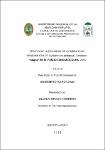| dc.contributor.advisor | Pérez Marín, Miguel Aristides | |
| dc.contributor.author | Tirado Herrera, Gloria | |
| dc.date.accessioned | 2019-07-23T15:21:43Z | |
| dc.date.available | 2019-07-23T15:21:43Z | |
| dc.date.issued | 2019 | |
| dc.identifier.uri | http://repositorio.unapiquitos.edu.pe/handle/20.500.12737/6268 | |
| dc.description.abstract | La investigación se desarrolló en el proyecto raíces y tubérculos de la Facultad de Agronomía, Zungarococha, distrito de Iquitos, provincia de Maynas, región Loreto, con el objetivo de evaluar el efecto de la densidad de siembra sobre el rendimiento en Cyclanthera pedata (L.) Schrader “caigua” en Zungarococha, año 2016. Se empleó el diseño estadístico de Bloque Completo al Azar (DBCA) llamado experimento con dos criterios de clasificación por tener dos fuentes de variación: tratamientos y repeticiones. El diseño tuvo cuatro (4) tratamientos y tres (3) repeticiones, haciendo un total de 12 unidades experimentales.
La Cyclanthera pedata (L) Schrader “caigua” es una especie cultivada hace milenios de años por los antiguos pobladores del Perú (Imperio de los Incas, que posteriormente fue distribuido su cultivo en diferentes regiones del Perú. La importancia de la especie nace por su uso en la alimentación y en la medicina tradicional. Es una especie que, al ser adaptado su cultivo en la selva baja amazónica, ha sufrido una serie de trastornos relacionado a su sensibilidad especialmente al ataque de enfermedades producida por hongos y al ataque de ciertas especies de insectos. Esta especie por sus características morfológicas es sensible cuando se cultiva en condiciones no apropiadas de clima y de suelo, por lo que se recomienda su cultivo en épocas de verano especialmente en los meses de junio y julio. Se ha logrado obtener los siguientes resultados: El mayor peso de los frutos correspondió al tratamiento T4 con un promedio de 50g y distanciamiento de 3.0 m x 3.0 m; el mayor número de frutos por planta se obtuvo con el tratamiento T4, habiéndose alcanzado a producir 106 frutos. Respecto a la longitud del fruto, el mayor rendimiento se obtuvo en el tratamiento T3 con 15.67 cm como promedio y el mayor rendimiento de frutos promedio, se alcanzó en el tratamiento T2 con 4.78. Esta especie es perecedera por lo que se recomienda su rápido consumo a la distribución en los mercados en forma rápida después de la cosecha. | es_PE |
| dc.description.abstract | The research was developed in the project roots and tubers of the Faculty of Agronomy, Zungarococha, district of Iquitos, Maynas Province, Loreto region, with the objective of evaluating the effect of planting density on the performance of Cyclanthera pedata (L.) Schrader "Caiguá", the year 2016 in Zungarococha.
The statistical design and complete block design (RCBD) called experiment with two classification criteria for having two sources of variation: treatments and replications. The design had four (4) treatments and three (3) repetitions, making a total of 12 experimental units. The Cyclanthera pedata (L) Schrader "Caiguá" is a species cultivated for thousands of years by the ancient inhabitants of Peru (Empire of the Incas, which was subsequently circulated its cultivation in different regions of Peru. The importance of the species is born by its use in food and traditional medicine. It is a species that, to be adapted its cultivation in the low jungle of the Amazon, has suffered a series of disorders related to its sensitivity especially to the attack of diseases caused by fungi and to attack by certain species of insects. This species by its morphological characteristics is sensitive when grown in conditions that are not appropriate climate and soil, it is recommended that its cultivation in times of summer especially during the months of June and July. It has been achieved the following results: the greater weight of the fruits corresponded to the treatment T4 with an average of 50g and distancing of 3.0 m x 3.0 m; the largest number of fruits per plant was obtained with the treatment T4 and reached to produce 106 fruits. With regard to the length of the fruit, the increased performance was obtained in the treatment T3 with 15.67 cm on average and the highest yields of fruits average, was reached in the treatment T2 with 4.78. This species is perishable and it is strongly recommended that rapid consumption to the distribution in the markets quickly after harvest. | es_PE |
| dc.description.uri | Tesis | es_PE |
| dc.format | application/pdf | es_PE |
| dc.language.iso | spa | es_PE |
| dc.publisher | Universidad Nacional de la Amazonía Peruana | es_PE |
| dc.rights | info:eu-repo/semantics/openAccess | es_PE |
| dc.rights | Attribution-NonCommercial-NoDerivs 3.0 United States | * |
| dc.rights.uri | http://creativecommons.org/licenses/by-nc-nd/3.0/us/ | * |
| dc.source | Universidad Nacional de la Amazonía Peruana | es_PE |
| dc.source | Repositorio institucional - UNAP | es_PE |
| dc.subject | Rendimiento de cultivos | es_PE |
| dc.subject | Espaciamiento | es_PE |
| dc.subject | Caigua | es_PE |
| dc.subject | Cyclanthera pedata | es_PE |
| dc.title | Efecto de la densidad de siembra en el rendimiento de Cyclanthera pedata (L) Schrader - "caigua" en el fundo Zungarococha. 2016 | es_PE |
| dc.type | info:eu-repo/semantics/bachelorThesis | es_PE |
| thesis.degree.discipline | Agronomía | es_PE |
| thesis.degree.grantor | Universidad Nacional de la Amazonía Peruana. Facultad de Agronomía | es_PE |
| thesis.degree.level | Título Profesional | es_PE |
| thesis.degree.name | Ingeniero(a) Agrónomo | es_PE |
| thesis.degree.program | Presencial | es_PE |
| dc.subject.ocde | Agricultura | es_PE |
| dc.subject.ocde | http://purl.org/pe-repo/ocde/ford#4.01.01 | es_PE |


